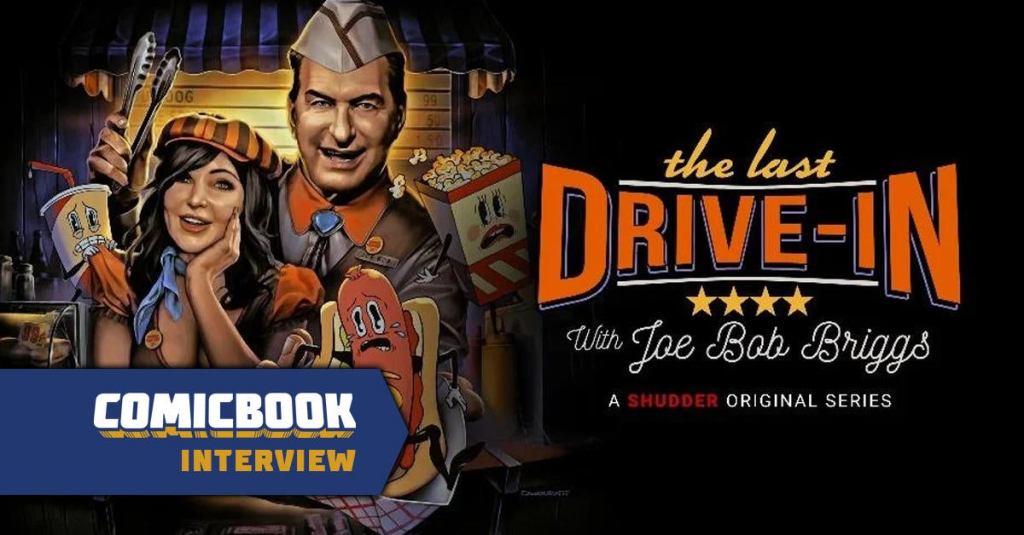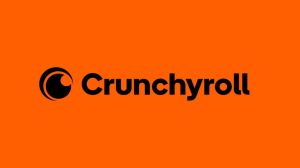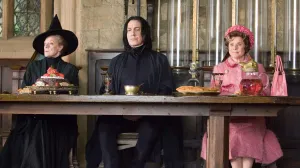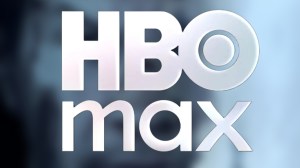Movie fans typically show their love of horror most in the weeks leading up to Halloween, but devout horror fans can celebrate their love of all things spooky all year long, thanks to streaming service Shudder. One of the ways in which fans can come together is by watching The Last Drive-In with Joe Bob Briggs, as host Briggs and cohost Diana Prince (a.k.a. “Darcy, The Mail Girl”) offer insight into each film shown during an episode, all while fans themselves connect on social media. The weekly series was recently renewed for a Season 6, which includes the upcoming Joe Bob’s Helloween special, featuring a surprise double feature of films celebrating All Hallow’s Eve. Joe Bob’s Helloween will premiere on ShudderTV on Friday, October 20th at 9 p.m. ET.
Videos by ComicBook.com
On The Last Drive-In, Briggs, the world’s foremost drive-in movie critic hosts eclectic horror movies, talking about their merits, histories, and significance to genre cinema. Shudder and Briggs first teamed up in July 2018, for the 27-hour marathon intended to be Briggs’ final farewell to televised movie hosting. After the special turned out to be an unprecedented hit, Shudder brought The Last Drive-In back as a weekly series and for multiple holiday specials.
ComicBook.com caught up with Briggs to talk about how a horror host celebrates Halloween, his approach to Season 6, and how his connection to the horror community has changed over the decades.

ComicBook.com: For you, someone who’s immersed in horror all year round, are you somebody who looks forward to Halloween? Do you get excited in October or does it just mean you’ve got a busier schedule?
Joe Bob Briggs: I’m always working on Halloween and I used to not think that was a good thing, but then, at some point, I just decided to really embrace it, and so I go to everything. I go to Halloween Horror Nights at Universal and I go to the one at Disney and I go to the one at Knott’s Berry Farm. I always find fans of the show at these places, and so I’ve now become one of those crazy, haunted-house people who has to go to every haunted house. So yeah, I guess I’ve become … I used to be just the guy who talked to people about horror and now I’m one of those crazy horror fans myself.
Now that we’re gearing up for a new season of The Last Drive-In, we have new episodes, when you approach a new season, do you aim to set a new season apart from what came before it or is it almost more of a goal of trying to create a uniform experience from start to finish?
Well, the uniform part of it is just the format, but I don’t like to repeat ourselves. We could make people very happy just by showing obscure, ’80s slashers all the time, but we’re trying to show every subgenre of horror in the history of the world. That means we have to occasionally test the patience of our audience. And so far, our audience has been willing to go with us wherever we go.
The most brutal thing that we did, we had VHS Night, those movies from the ’80s that were just shot straight on VHS and then somehow got into the video stores. We actually awarded Ironman certificates for anybody who could get through that night and write coherent plot synopses of both movies. We had to send out about 800 of those because people actually sent them in and were really serious about it. Some people wrote 30 pages to get their Ironman certificate. Actually, I’ve had people say, “Hey, you ever going to do VHS Night again?” Normally my answer would be, “No, we’re not,” but if enough people want to do that again, I mean, we might do it again. But that was one that’s way off the radar of most people.
Then we did a Nosferatu double feature on the 100th anniversary of Nosferatu. Normally, if you’re a programmer, you say, “Don’t make people read subtitles, don’t show silent films, don’t show black-and-white stuff. These are all the rules of television. You don’t do this. Don’t show weird artsy foreign films.” So we showed Nosferatu with the original score and we showed the Werner Herzog remake of Nosferatu, which is the exact same movie made in 1979 with sound, but it is in German. And well, lo and behold, people stayed with us throughout the entire evening and got deep into the history of the original. He’s not the original vampire, but we think of him as the original vampire. So that was another one where, normally, if you were at a programming meeting, you would say, “No, don’t do that. Everyone’s going to surf out in the first 20 minutes.” But everyone stayed with us.
I want to do more programming like that, where we say, “We’re going on a journey tonight. And it may not be what you expect, but when it’s over, you’re going to thank us.” So that’s our philosophy of programming, and then, occasionally, we just show, “This is party night. This is a brainless party movie.” We do those, too.
You bring up a good point. You say that you don’t want to just repeat yourselves and sometimes you almost test the patience of the audience with movies that maybe they wouldn’t sit through otherwise. And you might be surprised to hear this, but some horror fans can get a bit cranky online, shocking as it may sound. But I know some people, when you show The Babadook or when you show Possession or something, that some people say, “These aren’t drive-in movies. What the hell are you doing?”
Oh, but they are drive-in movies and they are horror movies. They don’t have a very expansive definition of the word “horror” or the word “drive-in.” Ingmar Bergman’s Cries and Whispers played drive-ins in the ’70s, so there’s a lot of things you can show at a drive-in and there’s a lot of things that qualify as horror.
But, usually, when we get those complaints, that’s people — that’s the ’80s, slasher guys, and that’s what they want and they don’t want to veer off too far from that. I don’t want to say they’re all stoners, but they’re watching the show under the influence of something and they can’t go into the deep, deep, deep dives, they can’t follow the deep, deep, deep dives, that we’re going deep on the more complicated movies. A lot of people take a lot of substances while they’re watching the show and so we might lose them in the second movie.
I guess it sounds like, the fans who have a limited perception of what a drive-in movie or what a horror movie is, one, they should maybe work on expanding their horizons, and two, also trust that even if there’s one movie they don’t like, that they should stick around because the next week’s episode might be more up their alley?
Yeah. There’s two things going on here. One is people will say to me, “Hey, my favorite movie is X and I’ve watched it 50 times. Why have you never had it on the show?” Well, why would they want me to have it on the show? They’ve already seen it 50 times. They already know what they think about it, and so they want us to weigh in on movies that they love and they’re waiting around for the movie that they love to show up on the schedule. And here we are, we’re showing a Polish art film, Possession, and they say, “Well, this is not horror and this is not what I’m sitting here waiting for.” But it is, it is. Boy, it is serious horror. So that’s one thing that’s going on.
Then I meet all these fans, I meet them at the conventions, and we have everything from bikers who have more tattoos than you would think anyone could get in their lifetime to people that live in the suburbs and bring their three babies with them to the convention and everything in between. So all the subgenres of horror have an audience and we satisfy all those audiences, but we ask them to cross over. We ask them to watch really strange things like The Baby. I don’t know if you’ve watched The Baby, the night we showed that.
But a lot of people said, “This is a very disturbing movie. How did this get past the rating board in 1972 or whenever that was?” And people wouldn’t choose to sit down and spend their Friday night with their family watching The Baby. But when they do, when they’re asked to do it by us, they go along with it, and then there’s this “wow” reaction. It’s like, “Whoa, I never would’ve known that that existed in the universe if we hadn’t seen it on The Last Drive-In.”
That’s the reaction we want. That’s what we want to do. We want to bring things to people that they wouldn’t find on their own. We know, I mean, it’s a little bit arrogant of us, but we’re saying, “This is not a movie you want to see, but it’s a movie you need to see and after you see it, you will want to see it again.” It’s the arrogance of a curator, I guess you could say.
Being a horror host, being in the horror community for decades now, I wondered what changes you have noticed in the horror-fan community, either horror at large or horror fans who like MonsterVision and Last Drive-In? Then, on the other side of that, how dp you feel you have changed in those years? How has working with Darcy and the perspective that she brings, how do you feel like you have changed over the years?
Well, you’ve hit on two very important things. The main thing that’s changed since I started is the fan base has become more and more female. When I started, the horror fan base was probably 80% male. Today it’s probably 50/50, and women have changed the nature of horror. The female audience has changed the nature of what films get made and how they’re made, and so that’s one big change.
Then you mentioned Darcy. I wish you could see some of the testimonials that people do to Darcy when they come up to the signing table. People don’t expect the Mail Girl to be an icon and role model of third-wave feminism, but that’s what she is. People are always saying, “Oh, I admire you so much,” and she’s become a big deal in the horror community. She has a very different standard of what she likes in horror than I do, but I think that’s why we work together so well, is she can tell me things.
She’s one of those people that can go through all the franchises and tell you, “Well, number three and number six are good. Number eight sucks.” I can’t do that. I can’t remember the difference between Friday the 13th 2 and Friday the 13th 4, mainly because I watched them in the theaters. I watched them two years apart, or one year apart, but people who have binge-watched these franchises like Darcy, they really know their stuff, and so she’s the one who’ll say, “Oh no, don’t show Part 2, show Part 3, that’s the one everyone wants to see.”
What’s changed with me is, for years I was just sending out articles and books and TV shows into a void and I didn’t know who was watching. And then something happened in the internet era while I was off doing other stuff that created this cohesive community of horror lovers who are like no other audience that I’ve ever addressed. They are loyal and vigorous in their enthusiasm. You don’t have that — there’s not an action movie audience like that, there’s not a drama audience like that. The closest thing to it might be a Lifetime movie audience. But you know what? Most Lifetime movies are horror. Most Lifetime movies are psychological horror, and so it’s the same audience.
So the biggest change, for me, is being close to the audience and knowing what they think and getting that real-time reaction, and that’s wonderful for a guy who’s basically a writer, which means you’re lonely all the time, you’re working in a room with a blank wall and a computer. It’s great. It’s great to have all these friends, so that’s been the biggest change for me.
Joe Bob’s Helloween will premiere on ShudderTV on Friday, October 20th at 9 p.m. ET.
This interview has been edited for length and clarity. You can contact Patrick Cavanaugh directly on Twitter.








